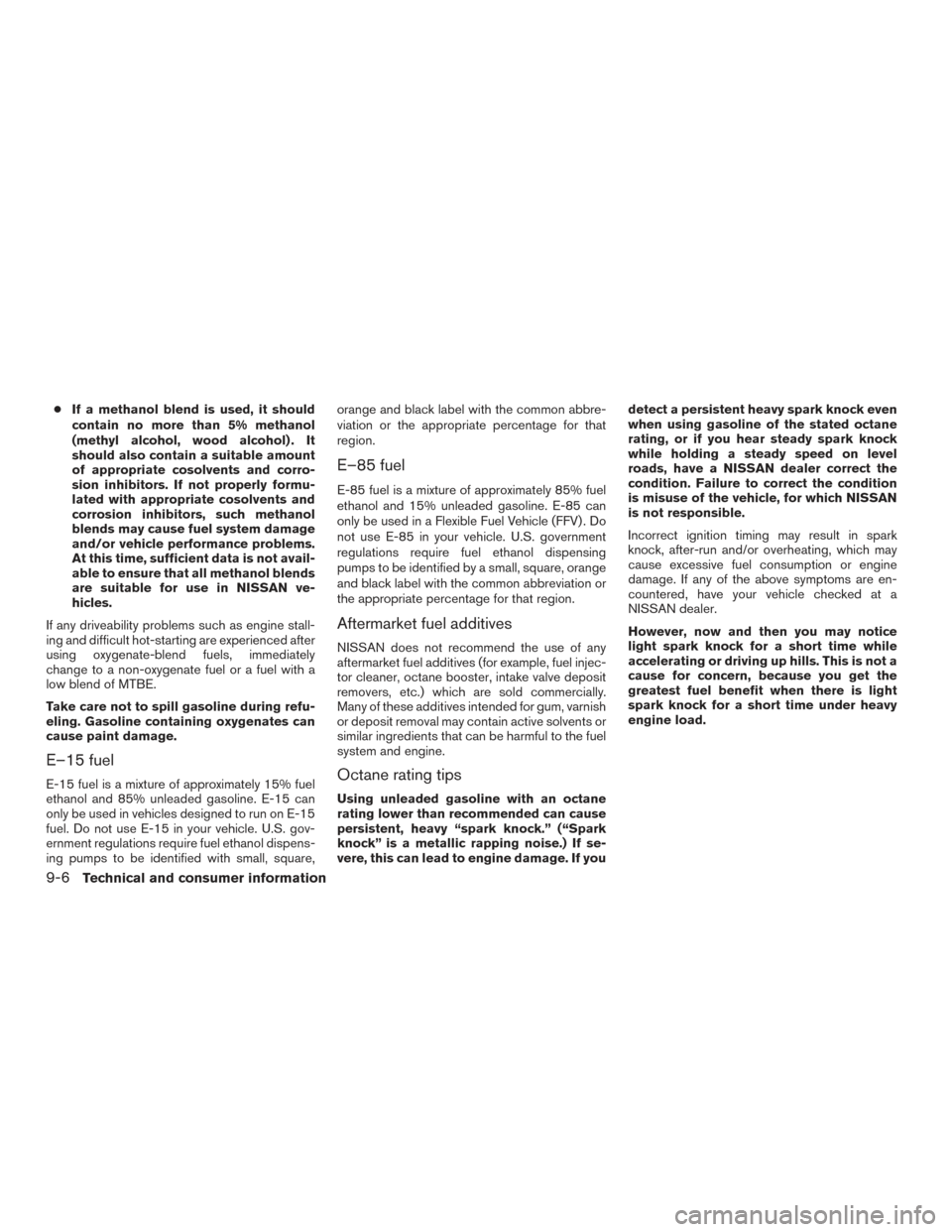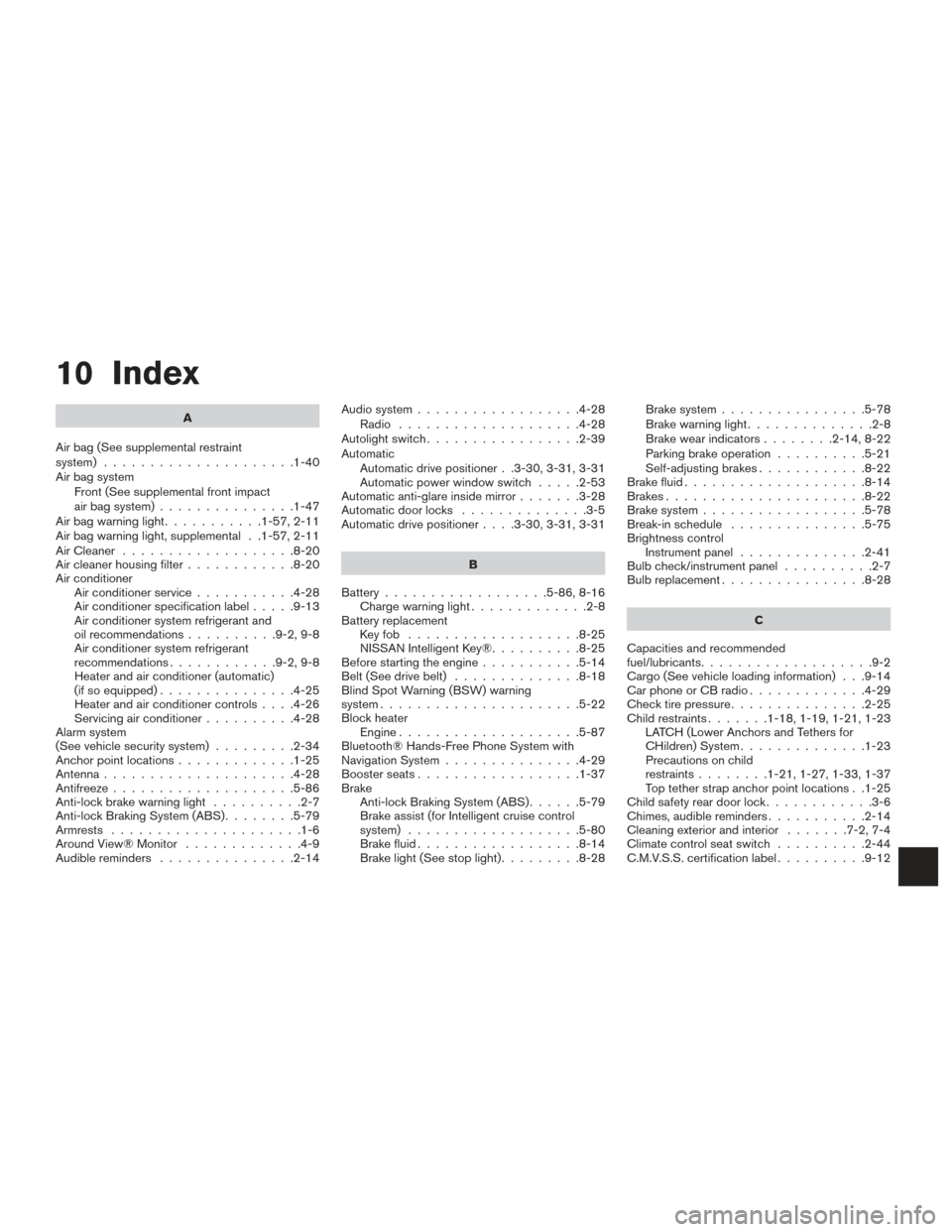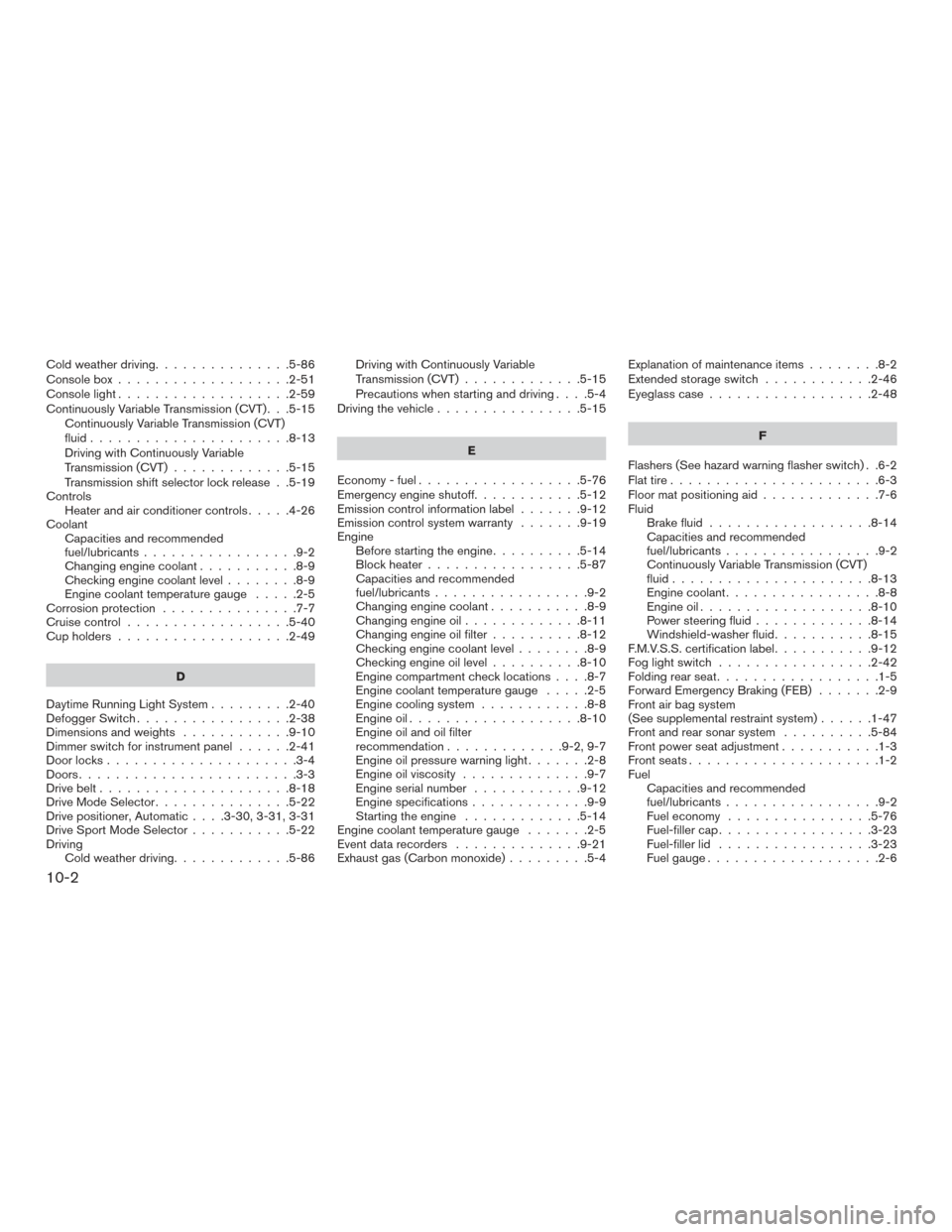check engine NISSAN MAXIMA 2016 A36 / 8.G Repair Manual
[x] Cancel search | Manufacturer: NISSAN, Model Year: 2016, Model line: MAXIMA, Model: NISSAN MAXIMA 2016 A36 / 8.GPages: 401, PDF Size: 4.66 MB
Page 361 of 401

●If a methanol blend is used, it should
contain no more than 5% methanol
(methyl alcohol, wood alcohol) . It
should also contain a suitable amount
of appropriate cosolvents and corro-
sion inhibitors. If not properly formu-
lated with appropriate cosolvents and
corrosion inhibitors, such methanol
blends may cause fuel system damage
and/or vehicle performance problems.
At this time, sufficient data is not avail-
able to ensure that all methanol blends
are suitable for use in NISSAN ve-
hicles.
If any driveability problems such as engine stall-
ing and difficult hot-starting are experienced after
using oxygenate-blend fuels, immediately
change to a non-oxygenate fuel or a fuel with a
low blend of MTBE.
Take care not to spill gasoline during refu-
eling. Gasoline containing oxygenates can
cause paint damage.
E–15 fuel
E-15 fuel is a mixture of approximately 15% fuel
ethanol and 85% unleaded gasoline. E-15 can
only be used in vehicles designed to run on E-15
fuel. Do not use E-15 in your vehicle. U.S. gov-
ernment regulations require fuel ethanol dispens-
ing pumps to be identified with small, square, orange and black label with the common abbre-
viation or the appropriate percentage for that
region.
E–85 fuel
E-85 fuel is a mixture of approximately 85% fuel
ethanol and 15% unleaded gasoline. E-85 can
only be used in a Flexible Fuel Vehicle (FFV) . Do
not use E-85 in your vehicle. U.S. government
regulations require fuel ethanol dispensing
pumps to be identified by a small, square, orange
and black label with the common abbreviation or
the appropriate percentage for that region.
Aftermarket fuel additives
NISSAN does not recommend the use of any
aftermarket fuel additives (for example, fuel injec-
tor cleaner, octane booster, intake valve deposit
removers, etc.) which are sold commercially.
Many of these additives intended for gum, varnish
or deposit removal may contain active solvents or
similar ingredients that can be harmful to the fuel
system and engine.
Octane rating tips
Using unleaded gasoline with an octane
rating lower than recommended can cause
persistent, heavy “spark knock.” (“Spark
knock” is a metallic rapping noise.) If se-
vere, this can lead to engine damage. If youdetect a persistent heavy spark knock even
when using gasoline of the stated octane
rating, or if you hear steady spark knock
while holding a steady speed on level
roads, have a NISSAN dealer correct the
condition. Failure to correct the condition
is misuse of the vehicle, for which NISSAN
is not responsible.
Incorrect ignition timing may result in spark
knock, after-run and/or overheating, which may
cause excessive fuel consumption or engine
damage. If any of the above symptoms are en-
countered, have your vehicle checked at a
NISSAN dealer.
However, now and then you may notice
light spark knock for a short time while
accelerating or driving up hills. This is not a
cause for concern, because you get the
greatest fuel benefit when there is light
spark knock for a short time under heavy
engine load.
9-6Technical and consumer information
Page 376 of 401

Due to legal requirements in some states and
Canadian Provinces, your vehicle may be re-
quired to be in what is called the “ready condi-
tion” for an Inspection/Maintenance (I/M) test of
the emission control system.
The vehicle is set to the “ready condition” when it
is driven through certain driving patterns. Usually,
the ready condition can be obtained by ordinary
usage of the vehicle.
If a powertrain system component is repaired or
the battery is disconnected, the vehicle may be
reset to a “not ready” condition. Before taking the
I/M test, check the vehicle’s
inspection/maintenance test readiness condi-
tion. Place the ignition switch in the ON position
without starting the engine. If the Malfunction
Indicator Light (MIL) comes on steady for 20 sec-
onds and then blinks for 10 seconds , the I/M test
condition is “not ready”. If the MIL does not blink
after 20 seconds, the I/M test condition is
“ready”. Contact a NISSAN dealer to set the
“ready condition” or to prepare the vehicle for
testing.This vehicle is equipped with an EDR. The main
purpose of an EDR is to record, in certain colli-
sion or near collision-like situations, such as an
air bag deployment or hitting a road obstacle,
data that will assist in understanding how a vehi-
cle’s systems performed. The EDR is designed to
record data related to vehicle dynamics and
safety systems for a short period of time, typically
30 seconds or less. The EDR in this vehicle is
designed to record such data as:
● How various systems in your vehicle were
operating;
● Whether or not the driver and passenger
safety belts were buckled/fastened;
● How far (if at all) the driver was depressing
the accelerator and/or brake pedal; and,
● How fast the vehicle was traveling.
● Sounds are not recorded. These data can help provide a better understand-
ing of the circumstances in which collisions and
injuries occur. NOTE: EDR data are recorded by
your vehicle only if a nontrivial collision situation
occurs; no data are recorded by the EDR under
normal driving conditions and no personal data
(e.g. name, gender, age and collision location)
are recorded. However, other parties, such as
law enforcement, could combine the EDR data
with the type of personally identifying data rou-
tinely acquired during a collision investigation.
To read data recorded by an EDR, special equip-
ment is required and access to the vehicle or the
EDR is needed. In addition to the vehicle manu-
facturer and NISSAN dealer, other parties, such
as law enforcement, that have the special equip-
ment, can read the information if they have ac-
cess to the vehicle or the EDR. EDR data will only
be accessed with the consent of the vehicle
owner or lessee or as otherwise required or per-
mitted by law.
READINESS FOR INSPECTION/
MAINTENANCE (I/M) TEST
EVENT DATA RECORDERS (EDR) (if
so equipped)
Technical and consumer information9-21
Page 378 of 401

10 Index
A
Air bag (See supplemental restraint
system) .....................1-40
Air bag system Front (See supplemental front impact
air bag system) ...............1-47
Airbagwarninglight...........1-57,2-11
Air bag warning light, supplemental . .1-57, 2-11
AirCleaner ...................8-20
Air cleaner housing filter ............8-20
Air conditioner Air conditioner service ...........4-28
Air conditioner specification label .....9-13
Air conditioner system refrigerant and
oil recommendations ..........9-2,9-8
Air conditioner system refrigerant
recommendations ............9-2,9-8
Heater and air conditioner (automatic)
(if so equipped) ...............4-25
Heater and air conditioner controls ....4-26
Servicing air conditioner ..........4-28
Alarm system
(See vehicle security system) .........2-34
Anchor point locations .............1-25
Antenna .....................4-28
Antifreeze ....................5-86
Anti-lock brake warning light ..........2-7
Anti-lock Braking System (ABS) ........5-79
Armrests .....................1-6
Around View® Monitor .............4-9
Audible reminders ...............2-14 Audio system
..................4-28
Radio ....................4-28
Autolight switch .................2-39
Automatic Automatic drive positioner . .3-30, 3-31, 3-31
Automatic power window switch .....2-53
Automatic anti-glare inside mirror .......3-28
Automatic door locks ..............3-5
Automatic drive positioner ....3-30,3-31,3-31
B
Battery ..................5-86,8-16
Chargewarninglight.............2-8
Battery replacement Keyfob ...................8-25
NISSAN Intelligent Key® ..........8-25
Before starting the engine ...........5-14
Belt (See drive belt) ..............8-18
Blind Spot Warning (BSW) warning
system ......................5-22
Block heater Engine ....................5-87
Bluetooth® Hands-Free Phone System with
NavigationSystem...............4-29
Boosterseats..................1-37
Brake Anti-lock Braking System (ABS) ......5-79
Brake assist (for Intelligent cruise control
system) ...................5-80
Brake fluid ..................8-14
Brake light (See stop light) .........8-28 Brake system
................5-78
Brakewarninglight..............2-8
Brakewearindicators........2-14,8-22
Parking brake operation ..........5-21
Self-adjusting brakes ............8-22
Brake fluid ....................8-14
Brakes ......................8-22
Brake system ..................5-78
Break-inschedule ...............5-75
Brightness control Instrument panel ..............2-41
Bulb check/instrument panel ..........2-7
Bulbreplacement................8-28
C
Capacities and recommended
fuel/lubricants .................. .9-2
Cargo
(See vehicle loading information) . . .9-14
Car phone or CB radio .............4-29
Check tire pressure ...............2-25
Child restraints .......1-18,1-19,1-21,1-23
LATCH (Lower Anchors and Tethers for
CHildren) System ..............1-23
Precautions on child
restraints ........1-21,1-27,1-33,1-37
Top tether strap anchor point locations . .1-25
Child safety rear door lock ............3-6
Chimes, audible reminders ...........2-14
Cleaning exterior and interior .......7-2,7-4
Climate control seat switch ..........2-44
C.M.V.S.S. certification label ..........9-12
Page 379 of 401

Cold weather driving...............5-86
Consolebox...................2-51
Consolelight...................2-59
Continuously Variable Transmission (CVT) . . .5-15 Continuously Variable Transmission (CVT)
fluid ......................8-13
Driving with Continuously Variable
Transmission (CVT) .............5-15
Transmission shift selector lock release . .5-19
Controls Heater and air conditioner controls .....4-26
Coolant Capacities and recommended
fuel/lubricants .................9-2
Changing engine coolant ...........8-9
Checking engine coolant level ........8-9
Engine coolant temperature gauge .....2-5
Corrosionprotection ...............7-7
Cruisecontrol..................5-40
Cupholders...................2-49
D
Daytime Running Light System .........2-40
Defogger Switch .................2-38
Dimensionsandweights ............9-10
Dimmer switch for instrument panel ......2-41
Door locks .....................3-4
Doors ........................3-3
Drive belt .....................8-18
Drive Mode Selector ...............5-22
Drive positioner, Automatic ....3-30,3-31,3-31
Drive Sport Mode Selector ...........5-22
Driving Cold weather driving .............5-86 Driving with Continuously Variable
Transmission (CVT)
.............5-15
Precautions when starting and driving ....5-4
Driving the vehicle ................5-15
E
Economy - fuel ..................5-76
Emergency engine shutoff ............5-12
Emission control information label .......9-12
Emission control system warranty .......9-19
Engine Before starting the engine ..........5-14
Block heater .................5-87
Capacities and recommended
fuel/lubricants .................9-2
Changingenginecoolant...........8-9
Changingengineoil.............8-11
Changing engine oil filter ..........8-12
Checking engine coolant level ........8-9
Checking engine oil level ..........8-10
Engine compartment check locations ....8-7
Engine coolant temperature gauge .....2-5
Engine cooling system ............8-8
Engineoil...................8-10
Engine oil and oil filter
recommendation .............9-2,9-7
Engine oil pressure warning light .......2-8
Engine oil viscosity ..............9-7
Engine serial number ............9-12
Engine specifications .............9-9
Starting the engine .............5-14
Engine coolant temperature gauge .......2-5
Eventdatarecorders ..............9-21
Exhaust gas (Carbon monoxide) .........5-4Explanation of maintenance items
........8-2
Extended storage switch ............2-46
Eyeglass case ..................2-48
F
Flashers (See hazard warning flasher switch) . .6-2
Flat
tire.......................6-3
Floor mat positioning aid .............7-6
Fluid Brake fluid ..................8-14
Capacities and recommended
fuel/lubricants.................9-2
Continuously Variable Transmission (CVT)
fluid......................8-13
Enginecoolant.................8-8
Engineoil...................8-10
Power steering fluid .............8-14
Windshield-washer fluid ...........8-15
F.M.V.S.S. certification label ...........9-12
Foglightswitch .................2-42
Foldingrearseat..................1-5
Forward Emergency Braking (FEB) .......2-9
Front air bag system
(See supplemental restraint system) ......1-47
Front and rear sonar system ..........5-84
Front power seat adjustment ...........1-3
Frontseats.....................1-2
Fuel Capacities and recommended
fuel/lubricants.................9-2
Fuel economy ................5-76
Fuel-filler cap .................3-23
Fuel-filler lid .................3-23
Fuelgauge...................2-6
10-2
Page 381 of 401

Warning labels (for SRS)..........1-57
LATCH (Lower Anchors and Tethers for CHildren)
System ......................1-23
License plate Installing the license plate ..........9-13
Light Airbagwarninglight.........1-57,2-11
Brake light (See stop light) .........8-28
Bulb check/instrument panel .........2-7
Bulb replacement ..............8-28
Charge warning light .............2-8
Console light .................2-59
ExteriorandInteriorlights..........8-28
Foglights...................8-27
Foglightswitch ...............2-42
Headlight and turn signal switch ......2-38
Headlight control switch ..........2-38
Headlights ..................8-27
Interiorlight..................2-58
Lightbulbs..................8-27
Low tire pressure warning light ........2-9
Low windshield-washer fluid warning
light......................2-24
Passenger air bag and status light .....1-49
Personal lights ................2-59
Security indicator light ............2-13
Spotlights(Seemaplight) .........2-60
Trunklight ..................2-60
Warning/indicator lights and audible
reminders ................2-7,2-12
Lights.......................8-27 Maplights ..................2-60
Lock Child safety rear door lock ..........3-6
Door locks ...................3-4
Gloveboxlock................2-50 Power door locks
...............3-5
Trunk lid lock opener lever ..........3-21
Loose fuel cap warning .............2-24
Lowfuelwarninglight ..........2-10,2-24
Low tire pressure warning light ..........2-9
Low windshield-washer fluid warning light . . .2-24
Luggage (See vehicle loading information) . .9-14
M
Maintenance Generalmaintenance.............8-2
Insidethevehicle...............8-3
Maintenance precautions ...........8-5
Outside the vehicle ..............8-2
Seatbeltmaintenance............1-18
Underthehoodandvehicle .........8-4
Maintenancerequirements............8-2
Malfunction indicator light ............2-12
Maplights ....................2-60
Map pocket ....................2-47
Memory Seat ............3-30,3-31,3-31
Meters and gauges ................2-3
Instrument brightness control ........2-41
Mirror Automatic anti-glare inside mirror ......3-28
Outside mirror control ............3-28
Outside mirrors ...............3-28
Vanity mirror .................3-27
Mirrors ......................3-28
Moonroof .................2-54,2-54
Moving Object Detection (MOD) ........4-20 N
NISSAN Intelligent Key® ..........3-2,3-6
NISSAN Intelligent Key® battery discharge
indicator .....................5-13
NISSAN Vehicle Immobilizer System . .2-35, 5-13
NISSAN voice recognition system .......4-30
O
Octane rating (See fuel octane rating) ......9-6
Odometer .....................2-4
Oil Capacities and recommended
fuel/lubricants.................9-2
Changingengineoil.............8-11
Changing engine oil filter ..........8-12
Checking engine oil level ..........8-10
Engineoil...................8-10
Engine oil and oil filter
recommendation .............9-2,9-7
Engine oil viscosity ..............9-7
Outside
mirror control ..............3-28
Outside mirrors .................3-28
Overheat If your vehicle overheats ...........6-10
Owner’s manual order form ...........9-22
Owner’s manual/service manual order
information ....................9-22
P
Parking Parking brake operation ...........5-21
10-4